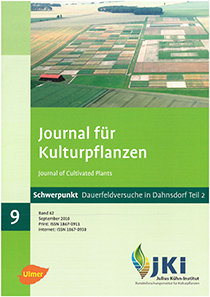Effect of biological plant protection products (azadirachtin, <em>B.t.t.</em>, pyrethrum, spinosad) on Colorado potato beetle (<em>Leptinotarsa decemlineata</em> <em>Say</em>) and their side effects on aphid predators in organic potato fields
DOI:
https://doi.org/10.5073/JfK.2010.09.03Keywords:
Organic farming, plant protection, Colorado potato beetle, beneficial insects, spinosad, neem, Bacillus thuringiensis, pyrethrumAbstract
In organic farming, preventive measures frequently do not provide sufficient control of the Colorado potato beetle (CPB, Leptinotasara decemlineata Say), and treatments (e.g. plant protection products, PPPs) are needed to ensure crop safety. In the present study, we compared the efficacy of four biological insecticides – Spruzit Neu (pyrethrum, 4.59 g/l), Novodor FC (Bacillus thuringiensis var. tenebrionis (B.t.t.), 20 g/l), NeemAzal-T/S (neem, 10 g/l) and SpinTor (spinosad, 480 g/l) – against this pest in certified organic fields from 2004 to 2009.
Split application of neem and B.t.t. significantly reduced the percentage of defoliation due to larval feeding and significantly increased the potato yields, particularly when neem was applied first followed by B.t.t. up to five days later. This even made it possible to reduce the doses of the two products. At the same time, this strategy reduces the risk of resistance to one of the products. Combined application of neem and B.t.t. in tank mixes was inferior to split application of the two products.
Because of its low cost and high efficacy, it is likely that farmers would prefer the spinosad product. A single spinosad treatment was more than 80% effective, even in the difficult test conditions in 2009. However, considering the potential for resistance development, it is recommended to change insecticides each year. In three years of field experiments, pyrethrum (Spruzit Neu) did not achieve a significant reduction of CPB larvae.
Because the PPPs remain effective only a few days after application, optimal timing of their application is crucial. The SIMLEP3 forecasting model is useful for determining the optimal timing of treatment. The field data collected showed excellent agreement with the predictions of the simulation model except for 2009.
The numbers of beneficial insects in the experimental potato fields were very low in all years. Ladybirds of the species Coccinella septempunctata L. and Harmonia axyrides Pallas were the most dominant predators. In 2008, we found a positive side effect of biological pesticides on the number of beneficial insects. Compared to untreated controls, increased numbers of beneficial insects were found in crops treated with spinosad (significant difference) 25 days after spraying. This difference was due to the foliage loss caused by the CPB larvae feeding in the untreated controls, which destroyed the habitat for aphids and their predators.
Downloads
Published
Issue
Section
License
The content of the journal is licensed under the Creative Commons Attribution 4.0 License. Any user is free to share and adapt (remix, transform, build upon) the content as long as the original publication is attributed (authors, title, year, journal, issue, pages).
The copyright of the published work remains with the authors. The authors grant the Journal of Cultivated Plants, the Julius Kühn-Institut and the OpenAgrar repository the non-exclusive right to distribute and exploit the work.







